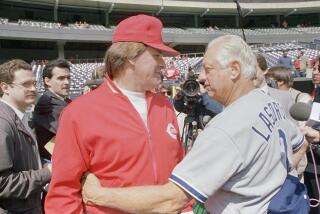Life and Times of Jim Brown
An infomercial is an infomercial, but it can be a fascinating infomercial. “Jim Brown: All-American” is that kind of film production because it is about one of the most compelling athletes of all time and one of the most debatable.
As an athlete, Brown was much more than the greatest running back of all time. As an individual, his insights and efforts toward boosting the black community remain beyond the ambition of all but a few black athletes. His box-office success as a movie star was far beyond any athlete, and as such he broke limitations for black actors. He remains an outspoken and articulate figure who can hold an audience.
And at present he is in jail, serving six months in California.
“Jim Brown: All-American” is a worshipful production by Spike Lee, who takes a worshipful stance about athletes. It opens at the Film Forum in downtown Manhattan on Friday and will play on HBO in December. It runs 130 minutes, which is long for television, and in a movie house it needs a special audience.
But it is about Jim Brown, who does have a certain fascination. He grew up in Manhasset, N.Y., as the greatest athlete ever on Long Island. What he accomplished in the NFL makes a joke of hysterical claims about other running backs. As a champion of black improvement and black economics, he never fails to show affection for Ed Walsh, his Manhasset football coach, Ken Molloy, the attorney who raised money to send Brown to Syracuse when the school refused a scholarship, and other white figures who influenced his life. He makes so much sense in his political and economic projects.
At the same time the performance chart of his life is full of paternity suits, assault charges, violence and the landmark charge that he threw a lover off a balcony. The promotion for the film says Lee “neither ignores nor minimizes the underside,” but comes to grips with the balcony charge. Brown says Eva Marie Bohn-Chinn actually was coming to his defense when the police arrived, and she jumped. On camera she says, “He was coming at me,” and the next thing she knew she was waking up in the courtyard, and, “Why would I jump?”
There is no minimizing Brown’s athletic greatness especially when “great” is often routine. He was perhaps the greatest lacrosse player ever. He was a world-class decathlete. He was an outstanding college basketball player. As a football player, he was most valuable player and rookie of the year in 1958, and he was MVP for the second time in his last season before retiring in 1965 at 29. He led the league in rushing eight of his nine seasons. For his career he averaged a stupendous 5.22 yards a carry. He missed half of one game. He won one NFL championship.
In Brown’s nine seasons, the New York Giants won five division championships. His battles with the Giants and linebacker Sam Huff were monumental.
Lee highlights the drubbing of the Colts in the ’64 championship game. He never mentions the Giants, who beat the Cleveland Browns three times in ’58 to get to the famous overtime championship. In the playoff game, Huff and the Giants held Brown to eight yards in seven carries.
Brown left football because he was in the movies, making “The Dirty Dozen” and couldn’t get back to start the season. Lee identifies him as “the black John Wayne.” Well, neither Brown nor his films were nominated for Oscars, but mostly they were interesting viewing. He was a breakthrough in that he was the first black actor permitted to be an action star and a sexual figure--even with white women.
Lee always shows Brown wearing his green African cap called a kufi, and always with biceps bulging from a sleeveless shirt. A film historian says Brown created the era of blaxploitation.
All the while he was creating the Negro Industrial and Economic Union “to urge blacks to get involved in economics,” particularly athletes who never gave a dime of thought to anything like that. To Brown that’s far more relevant than whether there are two or 30 black head coaches. In the ‘80s he created Amer-I-can to inspire inner-city youth and the program has spread to 23 states.
And then we go back to the long line of personal issues, beginning when he was living at the home of his high school girlfriend in Roslyn and going out with other girls. When Lee’s film mentions the mother of Brown’s children, it often doesn’t specify which mother. The first paternity suit was filed for a 2-year-old in 1960, two years after Brown’s first marriage.
The film ends with the birth of Brown’s most recent son. At present Brown is serving time for attacking with a shovel the car his present wife, Monique, was driving. He refused to go to counseling and to spend 40 days on a work crew cleaning the streets.
He is not a one-way man.
More to Read
Only good movies
Get the Indie Focus newsletter, Mark Olsen's weekly guide to the world of cinema.
You may occasionally receive promotional content from the Los Angeles Times.










